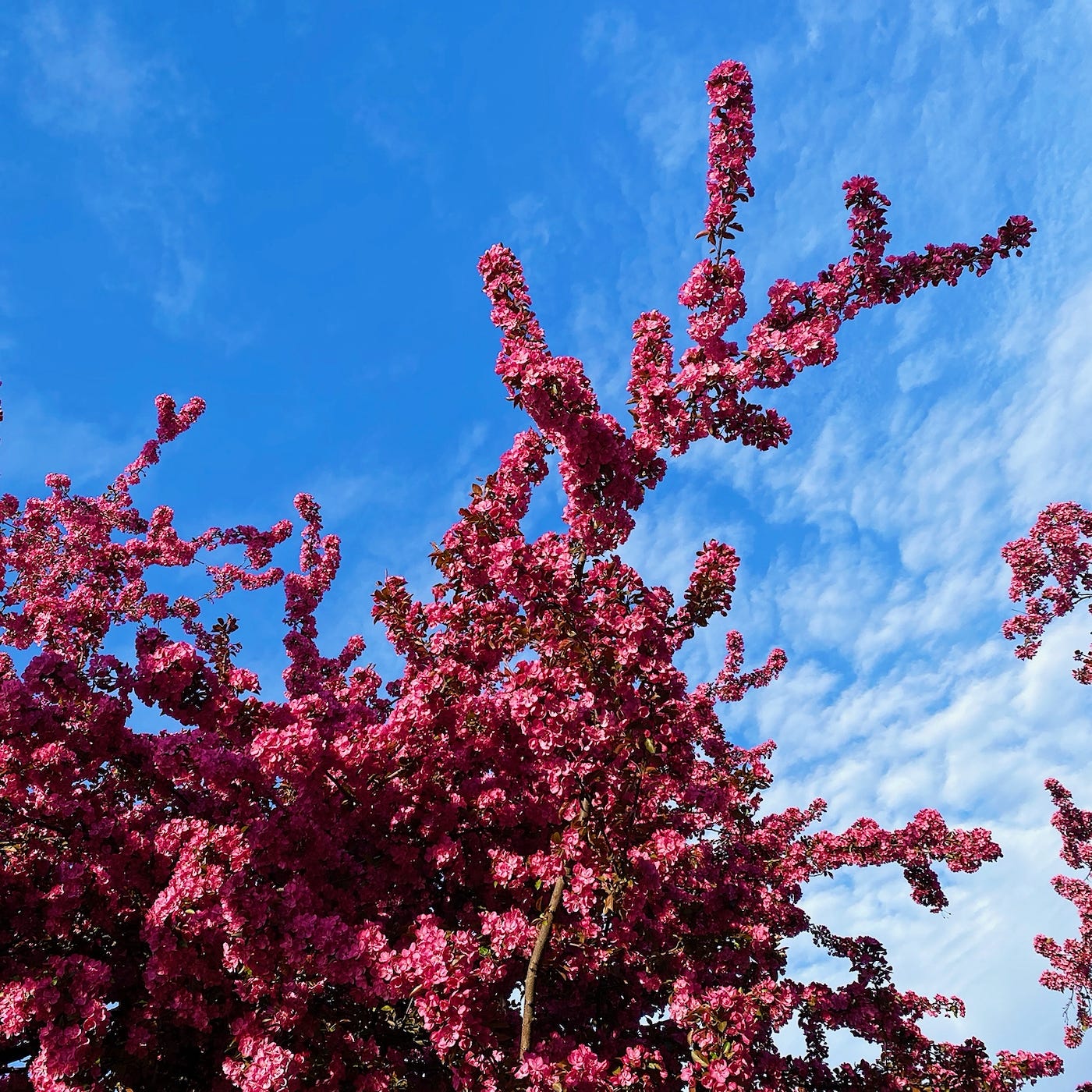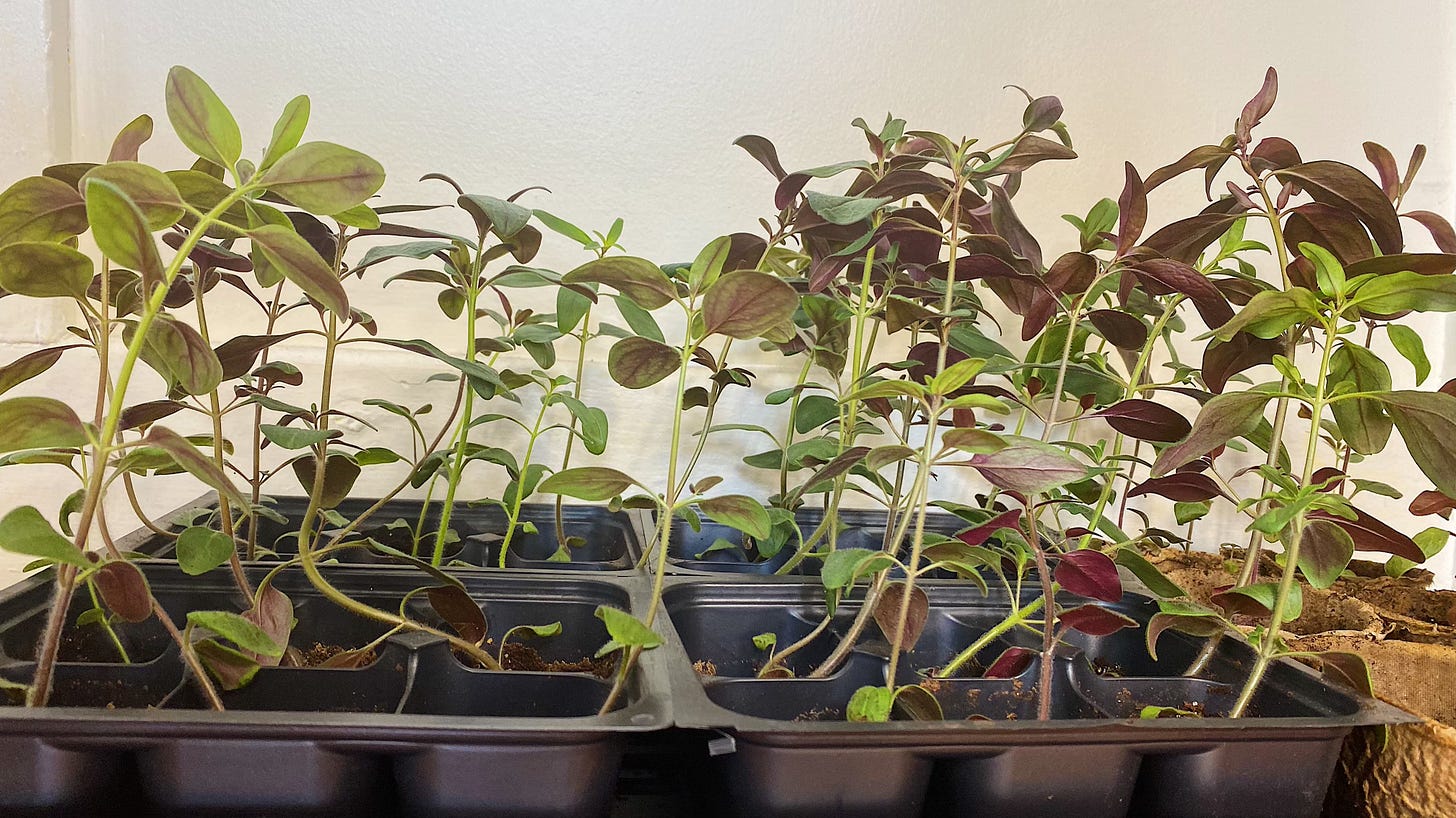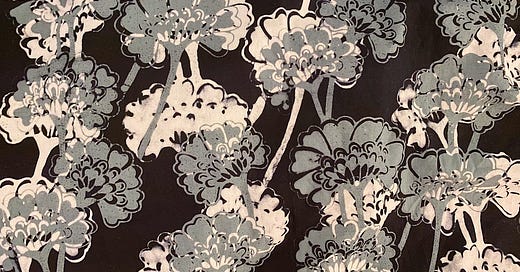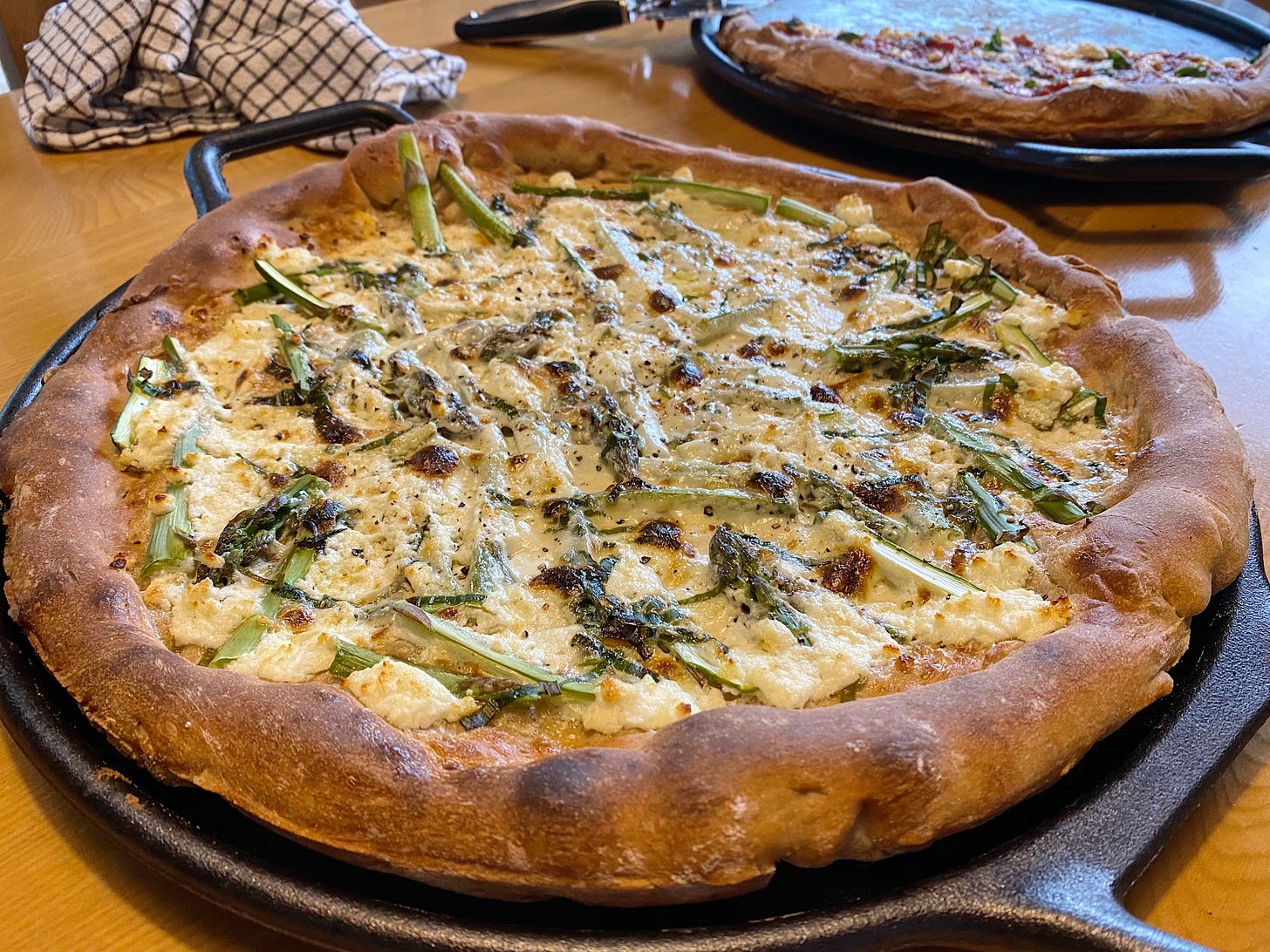The Possibility of Beauty
Some fragmented thoughts on the intersection of faith and beauty, growing things, meals with friends, and a modern psalm
Thursday, May 20
Grand Rapids, Mich.
Greetings, reader!
Confession: During the pandemic, I fell out of the habit of looking in the mirror. There was just no reason for it. Tristan made vows, and he’s ridiculously gracious, even when I’m wearing 20-year-old t-shirts dotted with holes. Fozzie is losing his eyesight, and all he cares about are walks, treats, and belly scratches. Some days—say, for a particularly important Zoom call or to preach online—I managed to pull on a good shirt, but rarely remembered to put any product in my overgrown COVID-era hair.
A couple of weeks ago, I had the opportunity to lead a group at a church in West Michigan through a conversation about beauty. What is it—and what is it for? How does it intersect with our faith? Why does it matter?
As I did my prep work, I thought back to my years in New York and London, and how obsessed I was with my clothes, my hair, my outward appearance. Everything was lacking, but I felt I could buy my way toward beauty. Really, I was channeling pain and frustration around what I couldn’t control—“you and your life choices make me sad,” a friend said to me during that season—into something I thought I could. Even if I was falling apart on the inside, at least I could look like I had it together on the outside.
I was chasing beauty, but an impoverished form of it—beauty as prestige, beauty as respectability, beauty as product. To be honest, I saw beauty as a cosmetic substitute for belovedness. Yes, I still really like a beautiful pair of shoes, but deep down, I think I always knew that I was hungering for more.
Recently, I stumbled across a short reflection by Thomas Troeger, who taught at Yale Divinity School, called “The Necessity of Beauty.” He makes a theological case for beauty, taking care to critique how beauty is often defined in our world. “We live in an age where beauty has been commercialized and degraded,” he writes. It has become commodified, thanks largely to “beauty products” and “the beauty industry.” For many of us, the word and the concept of “beauty” has come to reflect lack, stir a sense of insufficiency, and even feed our self-loathing—but fortunately, there’s an artfully packaged cream that, for $49, can help you fix all that. “Beauty is reduced to being young, fit, rich, and glamorous,” Troeger writes. “It is a lifestyle of extravagant consumption that is environmentally disastrous and often personally destructive.”
Troeger instead suggests finding not only solace but also hope in divine beauty. He advocates “a countercultural vision of what it means to be beautiful people and to lead a beautiful life.” He also suggests something I’d never considered: Divine beauty is prophetic. In other words, it rebukes the diminished understanding of beauty that society typically settles for and offers us an alternative picture not just of what’s possible but also of what’s right and good. Such a vision “employs beauty in nurturing justice and peace.” Such a vision deploys beauty as a signpost to wholeness.
Where Troeger argues that earthly beauty can help point us to God’s beauty, I hear echoes of John Calvin (go ahead and roll your eyes, if you just knew the Reformed guy was going to go there). I’ve got lots of problems with Calvin, not least his flawed understanding of the power of worms. But far from being a dour killjoy, he advocated for the arts as well as for a deep appreciation of beauty. “This world is correctly called the mirror of divinity,” he writes in his exegesis of the Letter to the Hebrews. “Not that there is sufficient clearness for humanity to gain a full knowledge of God by looking at the world, but the faithful, to whom he has given eyes, do see sparks of God’s glory, as it were, glittering in every created thing.”

During my conversation about beauty with the church folks, I was gratified that so much of the glorious glittering they identified was natural: blooming flowers, blossoming trees, the springtime return of early-morning birdsong. These all fit well under the rhetorical umbrella Calvin unfurls to encompass what’s beautiful. I love the idea of beauty as something that points us not just beyond ourselves but also to the ultimate good, to the divine, and to love—and so much of what we experience in the outdoors is there simply to be received, purely as God’s lavish grace.
I also want to add a careful footnote, though, because Calvin, too, can inadvertently be read to reinforce the notion of beauty as something that’s just there to be consumed. That’s where the artist-theologian Makoto Fujimura is especially helpful. Because he is a painter, much of his thought centers the arts, which he has described as “a cup that will carry the water of life to the thirsty. It’s not the water itself; it’s the vessel. What we are doing in the church today is we are just picking up the water with our bare hands and trying to carry it to the thirsty. We can still do it, but the effect is minimized by not fully utilizing what God has given us.”
Implicit in Fujimura’s words is an invitation. He beckons us to imagine, to create, to make—not just for our sake but also for that of our neighbor. In his recent book Art and Faith: A Theology of Making, Fujimura explores the idea of generating beauty as loving expression of our convictions as well as holy emulation of a creative God. “One aspect of our stewardship,” he writes, “is to become poets of Creation, to sing alongside the Creator over creation.”
I’m no poet; I don’t think I’ve written a poem since I was forced to in high school. And though Fujimura writes as an artist, I think his invitation extends well beyond genres traditionally identified as art. There is so much beauty in the ordinary. A grateful smile, an unexpected (but consented-to!) kiss, a burst of laughter—these are acts of creating beauty. You could cook a beautiful meal, knit a beautiful sweater, tell your kid a beautiful bedtime story, or write a beautiful word of encouragement to a loved one. You might grow some beautiful vegetables or flowers to be shared with someone who would enjoy them or use your gifts of organization to reimagine the beautiful possibilities of your partner’s disastrous closet. You could carve space out of your absurdly busy schedule to go to a restaurant with friends and revel in the beauty of the specific shared delight you create together, which would be impossible apart.
As creatures made in God’s image, as beloved children of a creative God, we were, Fujimura writes, “created to be creative, and we are by nature creative makers.” I’m convinced we all have the capacity to find beauty as well as to create it. And if Fujimura is right, we even hunger to express our creativity, though we don’t always understand how. In a society full of cheap beauty, how might it change the world if we invested in making the real and good thing?
Beauty that blesses.
Beauty that sings of love.
Beauty that joins the chorus of creation.
Beauty that restores our sense of wonder, awe, and resilience.
Beauty that rebukes the ugliness of scarcity and testifies to abundant life.
My goodness, that would be divine.
What I’m Growing: Our spare bedroom has become a ridiculous greenhouse. There’s dirt on the floor. I have dead seedlings scattered here and there. But there is life too! The snapdragons and tomatoes seem to be doing well, along with some other green things that I hope someday to be able to identify, because I failed to mark what I planted this year and I have no idea what they are. The basil looks healthy—and I even harvested some leaves for dinner last night (see below).

What I’m Cooking: We finally had friends over for dinner last Sunday, for the first time in months. Of course I cooked Chinese—cod with ginger and scallions, soy-glazed skirt steak (marinate it with mayonnaise... it sounds weird, but read this rationale by the food geek Kenji Lopez-Alt), Chinese greens with garlic, tofu stir-fried with asparagus, and braised mushrooms with the first bok choy from the backyard.
We hadn’t made pizza in a while, so last night, I did a pair: One was tomato, burrata, and basil fresh-picked from the spare room, which doesn’t sound quite as sexy as basil fresh-picked from the garden, but whatever. The other was a celebration of Michigan produce in springtime: asparagus, ramp, goat cheese, and mascarpone cream.
What I’m Listening to: Lately, with all the sorrow in the world, I keep coming back to the American soul singer Elayna Boynton’s aching rendition of Leonard Cohen’s “Come Healing,” which Alex Weston arranged and she recorded for the film “The Farewell.” “Come Healing,” which Cohen wrote when he was in his late 70s, is as beautiful a modern psalm as I’ve ever heard—and timely too: “And let the heavens hear it/ the penitential hymn/ Come healing of the spirit/ Come healing of the limb.”
That’s it from me for this week. Honestly, I don’t know if my ramblings about beauty make any sense; please read them as the beginning of a conversation, not in any way a conclusion. I’d love to know where you’re finding beauty around you, what beauty you’ve been making, and/or what beauty you’re resolving to create.
Thank you for spending this time with me. I’m so glad we can stumble through all this together, and I’ll try to write again soon.
Yours,
Jeff






I live less than an hour from Skyline Drive, in the Virginia Blue Ridge Mountains. During the pandemic, I've been driving there at least every other week. No matter what the season or the weather, it is an incredibly beautiful place. My spiritual director has helped me to think of these trips as time spent in prayer. I'm beginning to believe that he's right!
'Basil from guest room'😄
I smell the beauty of my lilac bush in full bloom. I see beauty in the tears we shed for the pain we witness.
I try to create beauty with the daily act of a family meal with my husband and teens.
Appreciate your words Jeff.